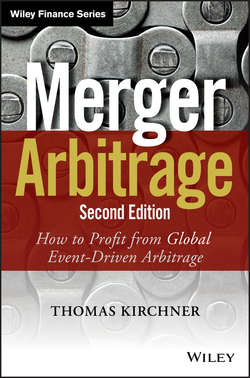Merger Arbitrage

Реклама. ООО «ЛитРес», ИНН: 7719571260.
Оглавление
Kirchner Thomas. Merger Arbitrage
Preface
Acknowledgments
Part One. The Arbitrage Process
Chapter 1. Introduction to Merger Arbitrage
Chapter 2. The Mechanics of Merger Arbitrage
Cash Mergers
Stock-for-Stock Mergers
Chapter 3. The Role of Merger Arbitrage in a Diversified Portfolio
Volatility of Stocks Going through a Merger
Merger Arbitrage Universe
Merger Arbitrage Spreads
Performance Characteristics of Merger Arbitrage
Performance of Merger Arbitrage outside the United States
Risk and Return of Merger Arbitrage Funds
Benefits of Merger Arbitrage in a Diversified Portfolio
Benefits of Merger Arbitrage in a Rising Interest Rate Environment
Quantitative Easing
Chapter 4. Incorporating Risk into the Arbitrage Decision
Probability of Closing
Severity of Losses
Expected Return of the Arbitrage
Part Two. Pitfalls of Merger Arbitrage
Chapter 5. Sources of Risk and Return
Deal Spread
Two Aspects of Liquidity
Beneficial Participation of Arbitrageurs
Timing and Speed of Closing
Dividends
Short Sales as a Hedge and an Element of Return
Leverage Boosts Returns
Covered Call Writing
Commissions and Portfolio Turnover
Bidding Wars and Hostile Bids
Chinese Companies
Chapter 6. Deal Structures: Mergers and Tender Offers
Mergers
Scheme of Arrangement
Tender Offers
Comparison of Mergers and Tender Offers
Burger King Provision: The Best of Both Worlds
SEC's Approach to Regulation
Chapter 7. Financing
Types of Debt Funding
Financing of Mergers versus Tender Offers
Uncertain Merger Consideration
Conflicted Role of Investment Banks
Fairness Opinions
Systemic Risk
Chapter 8. Legal Aspects
Merger Process
Corporation Codes
Takeover Code and Its Derivatives
Key U.S. Court Decisions
Takeover Defenses
Creeping Takeovers and Mandatory Acquisitions
Best Price Rule
Market Manipulation
Chapter 9. Management Incentives
Management Compensation
Continuing Management Interest in Private Equity Buyouts
Long-Term Planning in Management Buyouts
Milking a Company through Related Party Transactions
Chapter 10. Buyouts by Private Equity
Private Equity's Advantage
CEOs Don't Want to Sell to the Highest Bidder
Private Equity Funds Have Their Own Agenda
Buyouts as Financial Engineering
Activists Replace Private Equity
Chapter 11. Minority Squeeze-Outs
Boards' Lack Effectiveness during Squeeze-outs
Minority Shareholders Are in a Tough Spot
Family Control
Part Three. Investing in Merger Arbitrage
Chapter 12. Government Involvement
Antitrust Enforcement
Tax Policy
Securities Regulators
State and Provincial Governments
National Governments
China: The Great Wall of Laws
Trade Unions
Chapter 13. Four Ways to Fight Abuse of Shareholders in Mergers
“Just Sell” Is for Losers
The Rise of Shareholder Activists
Case for Activist Merger Arbitrage
Legal Tactics
Public Opposition
Chapter 14. Investing in Arbitrage
Trading versus Investing
Leverage and Options
Shorting Stocks
Transaction Costs
Managing the Cash Position
Risk Management
Merger Arbitrage Indices
Separate Accounts
Hedge Funds and Liquid Alternatives
About the Author
Exercises
CHAPTER 1
CHAPTER 2
CHAPTER 3
CHAPTER 4
CHAPTER 5
CHAPTER 6
CHAPTER 7
CHAPTER 8
CHAPTER 10
Отрывок из книги
Merger Arbitrage
How to Profit from Global Event-Driven Arbitrage
.....
Calculation of the annualized return works as in the example of a cash merger. Only the calculation of compound returns is shown here; simple interest can be calculated analogously. Unlike in the prior examples, the arbitrageur cannot find a direct reference to the closing date in the press release. “The merger will be implemented by way of a Scheme of Arrangement under the Australian Corporations Act 2001” gives a valuable hint. As I will explain later, a scheme of arrangement follows a well-defined timetable. A five-month time frame is a reasonable estimate. If we assume a closing date of February 28, 2013, then there are 162 days from September 19, the day the position was entered.
Compound interest
.....